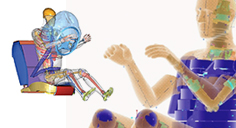News Center
News CenterWorldSID (World Side Impact Dummy): A World-Class Crash Test Dummy
We’re working with other automakers and government agencies to help keep everyone safer on the road. Our participation in the WorldSID crash test dummy project reflects our commitment to global cooperation.

An International Effort
Who is 5 feet 9 inches tall and speaks every language on the planet? It’s the WorldSID (World Side Impact Dummy) crash test dummy.
In development since 1997, WorldSID represents a first in automotive history since it was designed, developed and tested collectively by technical working groups from the Americas, Europe, Asia and Australia.
Standardizing Safety
Crash test dummies were historically developed for each region of the world to meet each region’s safety regulations. The differing safety requirements made developing vehicles with shared platforms and exporting vehicles throughout the world difficult.
To address this problem, Ford engineers joined hundreds of engineers, scientists, representatives of other auto manufacturers and government safety organizations to take part in the crash test dummy’s development. This consolidated effort resulted in a common crash test dummy, which helps to simplify testing procedures and safety regulation processes.
One Smart Dummy
The WorldSID crash test dummy is the most advanced crash test dummy in the world. It has 212 sensors, each of which capture data more than 10,000 times per second. These sensors help it measure head acceleration, pelvis forces and many other responses in the upper and lower extremities.
Closer to Human
The WorldSID crash test dummy also has the best biofidelity (a measure of how well the dummy simulates a human) of all side-impact dummies. Its biofidelity scores an 8.3 on the ISO Biofidelity Rating Scale of 0-10, with 10 being the best. The next closest mid-male dummy used for European regulation rates 4.4. The U.S. regulated dummy is rated at 2.3.
The excellent biofidelity of the WorldSID design is due in part to the use of new technologies and materials. WorldSID’s ribs, for example, achieve human-like deflection performance thanks to use of a new material. The chest deflection sensors are based on research led by Dr. Stephen Rouhana, a Ford Senior Technical Leader.
WorldSID made its official debut in June 2004 at a meeting of the Working Party on Passive Safety at the United Nations in Geneva, Switzerland.
Related
-
Bill Ford at TED 2011: The Issue of Global Gridlock
-
Ford and World Safety Leaders Work to Launch Intelligent Vehicles Quicker, More Affordably
-
Ford Crew Chief Telematics System Can Improve Fuel Economy by Up to 20 Percent Through Better Fleet Management
-
Ford Develops Heart Rate Monitoring Seat; Adds New Element to Health and Wellness Research







Connect With Ford
Ford Motor Company on Facebook
Ford Motor Company on YouTube
Follow @Ford on Twitter
Ford Motor Company on Flickr